How do you calculate a vertical shrink?
Vertical shrink is a mathematical transformation that involves modifying the vertical coordinates of points on a graph, resulting in a compression of the graph vertically. This transformation is commonly used in mathematics to manipulate functions and their graphs. Let's delve into the mathematics behind the vertical shrink transformation:
Mathematical Representation:Consider a function y = f(x). To apply a vertical shrink, you modify the function to y = k * f(x), where "k" is a positive constant greater than 0 and less than 1. This "k" factor represents the amount by which the y-coordinates of points on the graph are multiplied, causing the graph to shrink vertically.
Mathematically, the vertical shrink transformation can be represented as follows:y = k * f(x)
Effects on Graphs:The vertical shrink transformation affects the shape and height of the graph. Here's how it impacts the graph of a function:
Vertical Compression: When "k" is between 0 and 1, the resulting graph is compressed vertically. The y-coordinates of all points are multiplied by "k," causing the graph to become shorter along the vertical axis.
Vertical Scaling Factor: The factor "k" determines the degree of compression. The smaller the value of "k," the greater the compression. A value of "k" closer to 0 results in a more pronounced compression.
Example:Let's take a simple example using the function y = x^2. If we apply a vertical shrink by a factor of 0.5, the new function becomes y = 0.5 * x^2. In this case, the y-coordinates of every point on the original graph are halved, leading to a vertically compressed graph.
Applications:The vertical shrink transformation has applications in various mathematical contexts:
Function Manipulation: The vertical shrink transformation is one of the fundamental function transformations used to modify the behavior of mathematical functions.
Data Scaling: In data analysis and visualization, the vertical shrink transformation can be used to scale data vertically, making comparisons between data sets more manageable.
Economics and Finance: In economics and finance, the vertical shrink transformation can represent the impact of factors such as inflation or interest rate changes on a variable over time.
Physics: In physics, the vertical shrink transformation can model the attenuation of a quantity, such as sound or light intensity, over distance.
Understanding the mathematics behind the vertical shrink transformation is valuable for manipulating functions, analyzing data, and interpreting graphs in various mathematical and scientific disciplines.


